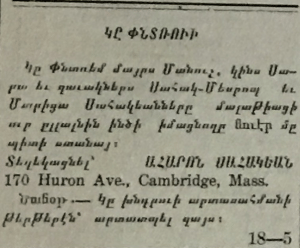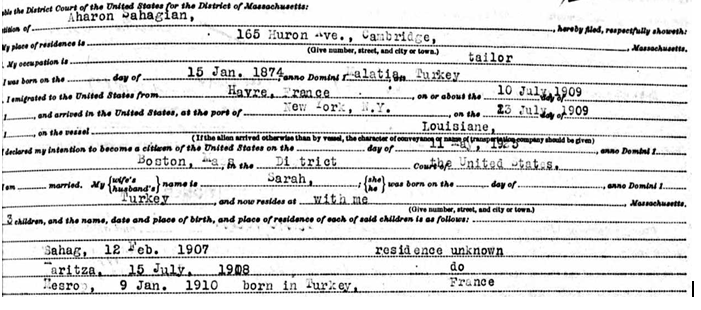Special for the Armenian Weeky
Have you ever wondered how Armenian families were able to reconnect during and after the genocide before the communication tools of today? There were those trapped in the diaspora, mostly men, desperate to hear any news of their families. At the same time, there were thousands of Armenians trapped in varied circumstances in the homeland and in Syrian refugee camps, often children with scant information about their families.
Recently, I was in the Hairenik building glancing through old issues of the “Hairenik Daily” and ran across the advertisements placed in the paper in hopes of learning the whereabouts of relatives. They start slowly at first in 1918 and then build in earnest in 1919. The desperation is palpable in just a few words beginning with, “Guh pndrem” (“I am searching”)…
“Gu pundrem ginus yev zavagnerus…” “I am searching for my wife and children Dikran and Artin Koyoghlian from Tomarza –Haji Melkon Koyoghlian.”
“Gu pundrem…” “I am searching for my mother Manoush, my wife Sara, and my children Sahag-Mesrob and Maritsa Sahagian of Malatia.”
 This ad was placed in 1919 by Aharon Sahagian of Cambridge, Mass. On his naturalization papers filed in 1927, we learn that Aharon’s wife Sara had been located and was now residing with him in Cambridge. We also learn from these papers that there was another son named Mesrob that was born soon after Aharon had left Malatia in 1910, and that son was now living in France.
This ad was placed in 1919 by Aharon Sahagian of Cambridge, Mass. On his naturalization papers filed in 1927, we learn that Aharon’s wife Sara had been located and was now residing with him in Cambridge. We also learn from these papers that there was another son named Mesrob that was born soon after Aharon had left Malatia in 1910, and that son was now living in France.
However, for the location of Sahag and Maritsa, it is simply stated “residence unknown.” I do not know the story of this family, but can imagine the cruel reality of those words, residence unknown.
On the other side of the world, those that had survived the trauma of the genocide were reaching out to find relatives known to have reached the United States. In the periodical “Gotchnag,” we find lists of those in the care of American institutions accompanied by the name of their relative presumably living in the United States. I found my grandfather’s first cousin, Hairabed Der Manouelian, listed in the American orphanage in Kharpert. It is the only evidence I have for how Hairabed made contact with his father, Asadour, who was living in Rhode Island. It would take more than five years for Hairabed to be reunited with his father. My grandfather joined him pretending to be another of Asadour’s sons.
In another issue of “Gotchnag,” we find a list of 72 women who were rescued from Turkish harems and were then living under American protection in Kharpert. How many were never rescued? We will never know, although their children and grandchildren are coming forward today to reclaim their Armenian identity.
In this, the 100th anniversary of the beginning of the greatest crime committed against our people, it seems appropriate to recall the herculean efforts at stopping the complete annihilation and attempt at repairing the family ruptures.
Today, there are a handful of people helping Armenians to recapture the family connections lost through time and memory. Of particular note is Mark Aslan, who manages the Armenian Immigration Project (http://arslanmb.org/ArmenianImmigrants/shiplists.html). He has done an incredible job of abstracting and indexing records and placing them in one location for easy access and searching. Through his efforts, and those who participate in Tracy Rivest Keeney’s Armenian Genealogy Facebook page, the advertisements from the Hairenik will be translated and made available.
Their cause is noble. It is not the only way to honor our ancestors, to fight the continued crimes against Armenians, but it surely belongs on the list, and I am thankful that Tracy and Mark and those like them have taken up the cause.



Can there BE any more important or vital work than this? To RECLAIM your family and relations?
God Bless These people and their work!!!!!!
These efforts must be expanded and FULLY and AMPLY financed. There should be banks of computerized records of every Armenian (and Anatolian Greek and Assyrian) family , their names, their ancestors names, the names of related families their ancestral homes etc. to facilitate Reunification and reidentification. Too much has already been lost; gather all whom you can!!!
My grandmother finally found her youngest brother in 1972
My grandmother, Annig Abroyan, didn’t find her brother until 1970. Near East Relief contacted her out of the blue all those years later. She was living in Syracuse NY, he was living in Athens GR. God rest their souls.
Great job .
God Bless the efforts
the old publications are available ? has to be an archive …I am interseted specially for the searching famille members
My family were looking for their lost brother since the Armenian genocide that took place in Urmia Iran. He is the brother of my great grandmother. His name is Mikhail Sarksyan, they lost him in Iran when they were escaping from the Turkish military. Please can someone direct me, where should I look?
With Mark and Tracey’s help, I was able to break through a brick wall in my Armenian genealogy that blocked me for more than 20 years. There would have been no way for me to find my ancestors’ extended family without these two wonderful people and their help. Thanks to both and I am eternally grateful to them.
Hey everyone im new here, my great grandmother lucine boghossian lost (missing) her two brothers ages ~8 and 12 during the Genocide that devastated Mush, Turkey where both her parents were killed. They were displaced – all 3 together in Russia, Leningrad (likely an orphanage), and the Red Cross sent her two brothers we believe to the US. She looked for them all her life, placed adds on the side streets of Russia, Syria etc, asked people from the Armenian community who had migrated to the US, and had no luck in finding them. Since I have had no great luck looking for them or their families. Is there a way I can be connected to an online resource or people that may help me find them – their names were Arakel and we think ‘Wahan’.